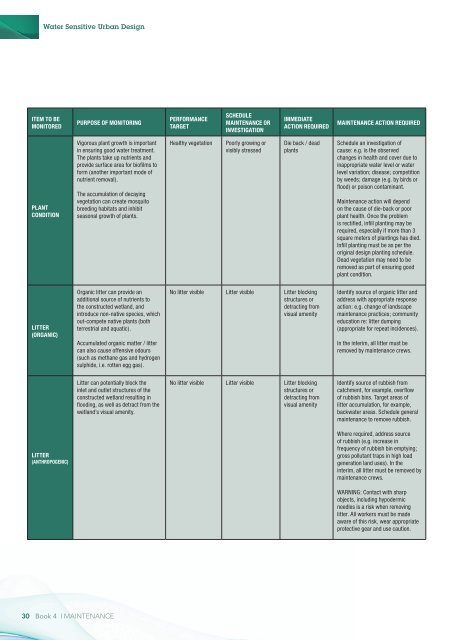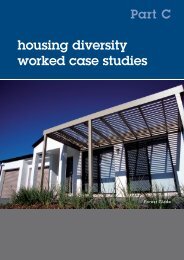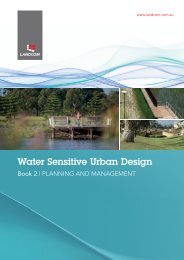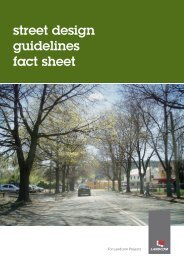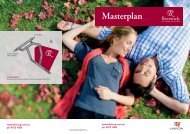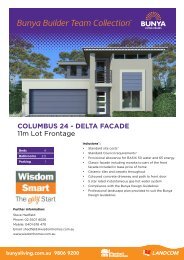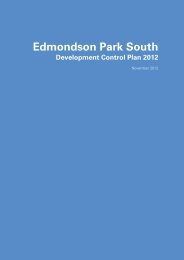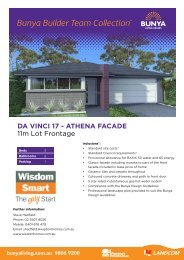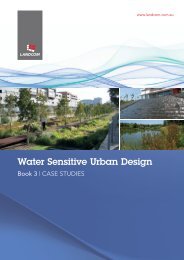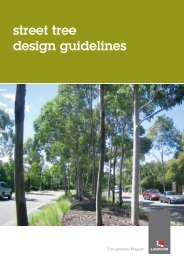Landcom Book 4 Maintenance - WSUD
Landcom Book 4 Maintenance - WSUD
Landcom Book 4 Maintenance - WSUD
You also want an ePaper? Increase the reach of your titles
YUMPU automatically turns print PDFs into web optimized ePapers that Google loves.
Water Sensitive Urban Design<br />
Item to be<br />
Monitored<br />
Purpose of Monitoring<br />
Performance<br />
Target<br />
Schedule<br />
<strong>Maintenance</strong> or<br />
Investigation<br />
Immediate<br />
Action Required<br />
<strong>Maintenance</strong> Action Required<br />
Plant<br />
Condition<br />
Vigorous plant growth is important<br />
in ensuring good water treatment.<br />
The plants take up nutrients and<br />
provide surface area for biofilms to<br />
form (another important mode of<br />
nutrient removal).<br />
The accumulation of decaying<br />
vegetation can create mosquito<br />
breeding habitats and inhibit<br />
seasonal growth of plants.<br />
Healthy vegetation<br />
Poorly growing or<br />
visibly stressed<br />
Die back / dead<br />
plants<br />
Schedule an investigation of<br />
cause: e.g. is the observed<br />
changes in health and cover due to<br />
inappropriate water level or water<br />
level variation; disease; competition<br />
by weeds; damage (e.g. by birds or<br />
flood) or poison contaminant.<br />
<strong>Maintenance</strong> action will depend<br />
on the cause of die-back or poor<br />
plant health. Once the problem<br />
is rectified, infill planting may be<br />
required, especially if more than 3<br />
square meters of plantings has died.<br />
Infill planting must be as per the<br />
original design planting schedule.<br />
Dead vegetation may need to be<br />
removed as part of ensuring good<br />
plant condition.<br />
Litter<br />
(organic)<br />
Organic litter can provide an<br />
additional source of nutrients to<br />
the constructed wetland, and<br />
introduce non-native species, which<br />
out-compete native plants (both<br />
terrestrial and aquatic).<br />
Accumulated organic matter / litter<br />
can also cause offensive odours<br />
(such as methane gas and hydrogen<br />
sulphide, i.e. rotten egg gas).<br />
No litter visible Litter visible Litter blocking<br />
structures or<br />
detracting from<br />
visual amenity<br />
Identify source of organic litter and<br />
address with appropriate response<br />
action: e.g. change of landscape<br />
maintenance practices; community<br />
education re: litter dumping<br />
(appropriate for repeat incidences).<br />
In the interim, all litter must be<br />
removed by maintenance crews.<br />
Litter can potentially block the<br />
inlet and outlet structures of the<br />
constructed wetland resulting in<br />
flooding, as well as detract from the<br />
wetland’s visual amenity.<br />
No litter visible Litter visible Litter blocking<br />
structures or<br />
detracting from<br />
visual amenity<br />
Identify source of rubbish from<br />
catchment, for example, overflow<br />
of rubbish bins. Target areas of<br />
litter accumulation, for example,<br />
backwater areas. Schedule general<br />
maintenance to remove rubbish.<br />
Litter<br />
(anthropogenic)<br />
Where required, address source<br />
of rubbish (e.g. increase in<br />
frequency of rubbish bin emptying;<br />
gross pollutant traps in high load<br />
generation land uses). In the<br />
interim, all litter must be removed by<br />
maintenance crews.<br />
WARNING: Contact with sharp<br />
objects, including hypodermic<br />
needles is a risk when removing<br />
litter. All workers must be made<br />
aware of this risk, wear appropriate<br />
protective gear and use caution.<br />
30 <strong>Book</strong> 4 | MAINTENANCE


